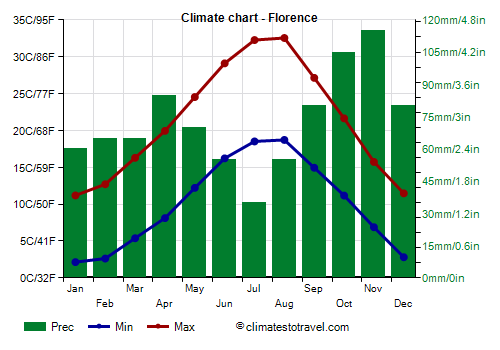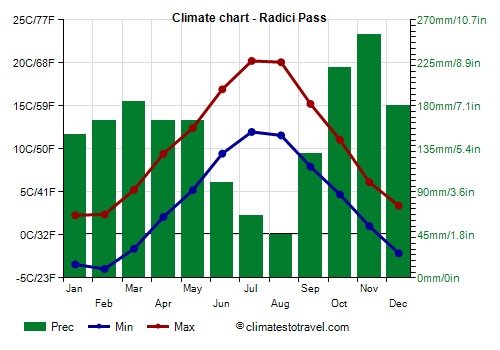Select units of measurement for the temperature and rainfall tables (metric or imperial).
Average weather, temperature, rainfall, sunshine hours
In Tuscany, a region of central Italy facing the sea to the west (Ligurian Sea and Tyrrhenian Sea) and crossed by the Apennines to the north and west, but also by hills in the inland areas, we have the following climatic zones:
- the
Mediterranean climate of the coast and neighboring areas (see Massa, Versilia, Pisa, Livorno, Maremma, islands), with mild, rainy winters and hot, sunny summers. In inland areas and on low-altitude hills (see Florence, Arezzo, Siena), the climate is similar, even though it is a little colder in winter, and often hotter in summer (in the valleys and inland plains).
- the climate of the
Apennines, generally temperate humid, but also cold in the mountains at the highest altitudes.
Plains and hills
Although the climate of Tuscany is generally mild, in winter, the
cold winds from the north or north-east, the "Tramontana" and the "Grecale", can blow, which can be strong especially where they are channelled between the mountains (such as in Versilia, the coastal area between Marina di Massa and Viareggio). Instead, the
mild winds from the south are stronger on the coast and on the islands.
In summer, the sea breeze blows in the afternoon, which is welcome as it tempers the heat.

In
Florence, the regional capital, the average temperature ranges from 6.5 °C (44 °F) in January to 25.5 °C (78 °F) in July and August. Here are the average temperatures.
Florence - Average temperatures (1991-2020) |
| Month | Min | Max | Mean |
|---|
| January | 2.2 | 11.2 | 6.7 |
|---|
| February | 2.6 | 12.7 | 7.7 |
|---|
| March | 5.4 | 16.3 | 10.8 |
|---|
| April | 8.1 | 20 | 14 |
|---|
| May | 12.2 | 24.5 | 18.4 |
|---|
| June | 16.2 | 29.1 | 22.7 |
|---|
| July | 18.5 | 32.3 | 25.4 |
|---|
| August | 18.7 | 32.6 | 25.6 |
|---|
| September | 15 | 27.1 | 21 |
|---|
| October | 11.2 | 21.6 | 16.4 |
|---|
| November | 6.9 | 15.7 | 11.3 |
|---|
| December | 2.8 | 11.5 | 7.1 |
|---|
| Year | 10 | 21.3 | 15.6 |
|---|
in the plains and hills of Tuscany varies greatly, and is more abundant in the north-west, at the foot of the Apuan Alps (see Massa, Carrara) and of the Apennines (see Lucca, Pistoia), where it reaches 1,200 millimeters (47 inches) per year. In the remaining part, it is often at an intermediate level, around 800-900 mm (31-35 inches, see Florence, Livorno, Siena, Arezzo), while in the southern coastal areas and in the smaller islands, it is quite scarce, since it drops below 600 mm (23.5 in) per year, but in some cases even below 500 mm (20 in, see Maremma south of Grosseto, Pianosa).
In general,
autumn is the rainiest season in Tuscany, and sometimes there can be floods.
Summer is the driest season, although thunderstorms can sometimes break out in the afternoon, especially in the areas closest to the mountains.
Here is the average precipitation in Florence.
Florence - Average precipitation| Month | Days |
|---|
| January | 60 | 8 |
|---|
| February | 65 | 7 |
|---|
| March | 65 | 8 |
|---|
| April | 85 | 10 |
|---|
| May | 70 | 8 |
|---|
| June | 55 | 6 |
|---|
| July | 35 | 4 |
|---|
| August | 55 | 5 |
|---|
| September | 80 | 6 |
|---|
| October | 105 | 9 |
|---|
| November | 115 | 9 |
|---|
| December | 80 | 8 |
|---|
| Year | 870 | 88 |
|---|
rarely falls in Tuscany, at least at low altitudes, both because the winter is quite mild and because the cold periods, with the wind from the north, are generally dry. Snow is very rare on the coast, while in inland areas, at a certain distance from the sea (see Florence), and perhaps at hill altitudes (see Siena, Arezzo), it can sometimes snow.
During
cold spells, which are becoming rarer due to global warming, the temperature can drop to around -5 °C (23 °F) on the coast, and to -7/-8 °C (18/19 °F) or below in the interior. In January 1985, during an exceptionally cold wave, it snowed throughout the region, and temperatures dropped to around -20 °C (-4 °F) in the interior valleys.
In summer, there can be
heat waves, which are becoming more frequent, during which the temperature can reach 35 °C (95 °F) along the coasts and 40 °C (104 °F) in inland areas. The hottest areas are the internal basins, such as that of Florence.
Tuscany is a
sunny region, especially along the central-southern part of the coast, where there are over 2,500 hours of sunshine a year. In general, however, the plains and inland hills exceed 2,300 hours of sunshine per year as well.

On the sea we find the islands of the
Tuscan archipelago, protected in a national park. The main islands are
Elba, Giglio, Capraia, Montecristo and Pianosa. In the islands the climate is even milder than on the coast.
Mountains
To the north, the mountain ridge of the Ligurian Apennines and the Tuscan-Emilian Apennines is very windy. In addition, precipitation is abundant, exceeding 2,000 mm (79 in) per year. Thunderstorms can break out in summer.
The highest peak in Tuscany is Monte Prado, 2,054 meters (6,738 feet) high, in the province of Lucca and on the border with Emilia-Romagna region, within the
Tuscan-Emilian Apennines National Park.

At the
Radici Pass, located in the same area, at an altitude of 1,525 meters (5,000 ft) above sea level, the average temperature ranges from -1 °C (30 °F) in January to 16 °C (61 °F) in July and August. Here are the average temperatures.
Radici Pass - Average temperatures (2006-2020) |
| Month | Min | Max | Mean |
|---|
| January | -3.4 | 2.3 | -0.6 |
|---|
| February | -4 | 2.4 | -0.8 |
|---|
| March | -1.6 | 5.2 | 1.8 |
|---|
| April | 2.1 | 9.4 | 5.8 |
|---|
| May | 5.2 | 12.4 | 8.8 |
|---|
| June | 9.4 | 16.9 | 13.2 |
|---|
| July | 12 | 20.2 | 16.1 |
|---|
| August | 11.6 | 20.1 | 15.8 |
|---|
| September | 7.9 | 15.2 | 11.6 |
|---|
| October | 4.7 | 11.1 | 7.9 |
|---|
| November | 1 | 6.1 | 3.6 |
|---|
| December | -2.1 | 3.4 | 0.6 |
|---|
| Year | 3.6 | 10.5 | 7 |
|---|
Precipitation amounts to 1,800 mm (71 in) per year.
Radici Pass - Average precipitation| Month | Days |
|---|
| January | 150 | 12 |
|---|
| February | 165 | 13 |
|---|
| March | 185 | 15 |
|---|
| April | 165 | 14 |
|---|
| May | 165 | 13 |
|---|
| June | 100 | 8 |
|---|
| July | 65 | 7 |
|---|
| August | 45 | 6 |
|---|
| September | 130 | 9 |
|---|
| October | 220 | 10 |
|---|
| November | 255 | 14 |
|---|
| December | 180 | 12 |
|---|
| Year | 1820 | 132 |
|---|
In the northwest, near the coast, we find the
Apuane Alps, a chain detached from the Apennines, in the provinces of Lucca and Massa-Carrara, which reach 1,946 meters (6,385 ft).
In central-southern Tuscany we find the
Metalliferous Hills, which reach 1,060 meters (3,478 ft), and further south,
Monte Amiata, an extinct volcano of 1,738 meters (5,702 ft).
Best Time
For a
beach holiday along the coasts and islands of Tuscany, the best period is the summer, particularly in July and August, since they are the hottest and sunniest months, and in which the sea is warmest as well.
To
visit the cities, given that it can be very hot in summer, you can choose the periods from mid-April to mid-June and from September to early October. In June, the weather is often good, but sometimes it can get very hot, especially in the second half of the month.
See also the
temperatures by month.